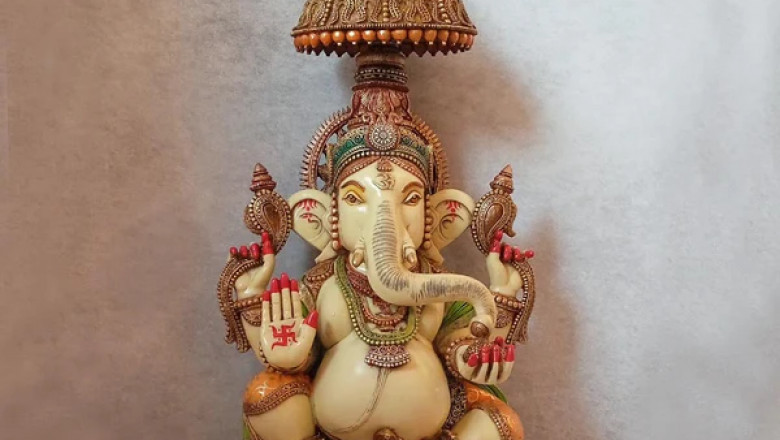views
Lord Ganesha holds a special place in every Indian home and heart. Revered as the remover of obstacles, the God of beginnings, and the patron of wisdom and intellect, Lord Ganesha is more than just a symbol—he is a spiritual presence. That’s why choosing a Ganesha idol for your home or workplace is a decision rooted in belief and intention.
Every form of Ganesha idol, whether seated, standing, dancing, or reclining carries its own meaning and energy. In this blog, we’ll explore the spiritual significance of different types of Ganesha idols, so you can choose the one that aligns with your purpose and space.
Seated Ganesha (Sukhakarta)

The seated form of Ganesha, often shown in Padmasana (lotus position) or a relaxed cross-legged pose, is among the most popular representations. Spiritually, this form radiates calm, peace, and centeredness. It symbolises a life of balance, contentment, and harmony.
This type of idol is ideal for:
● Homes where you want to cultivate inner peace and family unity
● Meditation or prayer rooms
● Spaces intended for reflection, grounding, or healing
It’s often chosen by individuals who seek a stable environment free from emotional or material turbulence.
Standing Ganesha (Shubh Labh Ganesha)

A standing ganesh idols for home is associated with movement, action, and readiness. Spiritually, this form encourages progress and is believed to bring prosperity, success, and new opportunities.
This idol works well in:
● Entryways or main doors (facing inward to invite blessings)
● Office spaces or business establishments
● Any area where you want to promote growth and positive momentum
It’s especially suited for those looking to start new ventures, careers, or financial journeys. The energy of this idol is active, assertive, and goal-oriented.
Dancing Ganesha (Nritya Ganapati)

The dancing form of Ganesha is a beautiful representation of joy, celebration, creativity, and divine rhythm. Known as Nritya Ganapati, this depiction shows the lord in motion balancing with one leg lifted and arms extended.
Spiritually, this idol channels:
● Vibrant energy
● Playfulness and enthusiasm
● Artistic and creative freedom
This form is best placed in:
● Art studios, music rooms, or creative workspaces
● Children’s play areas or family rooms
● Homes that seek to cultivate happiness, expression, and emotional lightness
It’s also a great choice for individuals going through stressful phases, as the dancing Ganesha radiates uplifting and positive energy.
Reclining Ganesha

Less commonly seen but visually striking, the reclining Ganesha idol depicts the lord resting on one side with a calm and relaxed expression. This pose symbolises luxury, prosperity, and ease of living.
Spiritually, the reclining form reflects:
● A life of abundance
● A state of mental and physical relaxation
● Control over desires and a sense of fulfillment
It is a beautiful addition to:
● Lounges or living rooms in modern homes
● Luxury spaces, hospitality areas, or upscale interiors
● Homes aiming to attract wealth, comfort, and graceful living
This idol is often chosen by those who have worked hard and now want to sustain a life of peace, success, and satisfaction.
Ganesha with Right vs Left Trunk
One of the most important yet often overlooked aspects of Ganesha idols is the direction of the trunk.
Left-Trunk Ganesha (Vamamukhi)

● The trunk curving to the left symbolizes peace, prosperity, and household harmony.
● It represents the moon’s energy, which is calming and nurturing.
● Ideal for daily worship at home, especially in households focused on family wellbeing.
Right-Trunk Ganesha (Dakshinabhimukhi)

● The trunk curving to the right is associated with the sun’s energy, representing discipline, strength, and power.
● Considered more ritualistic and spiritually intense.
● This idol requires strict adherence to traditional rituals and should be placed only if the devotee is committed to regular worship.
If you're looking for a Ganesha idol to keep for decorative or light devotional purposes, the left-trunk version is generally recommended. The right-trunk idol, while powerful, should be chosen with deeper spiritual intent and respect.
Conclusion
Every Ganesha idol carries its own story, symbolism, and energy. Whether you choose a seated Ganesha for inner peace, a dancing form for joy, or a standing one for prosperity, it’s important to align the spiritual intent of the idol with your personal goals and the energy you wish to invite into your space.
The beauty of Ganesha lies in his ability to adapt to all environments—traditional or modern, spiritual or artistic. By choosing the right form thoughtfully, you don't just decorate a space—you infuse it with meaning, emotion, and divine presence.
If you are looking to buy a Ganesha idol for your home, you should check out Satguru’s. They have one of the best Ganesha idol collections in Mumbai with a diverse variety of designs. Along with Ganesha idol, you can also check their other God idol collections like Lord Shiva, Lord Hanumana, Maa Tara, Maa Durga, and more. Shop Now.






















Comments
0 comment